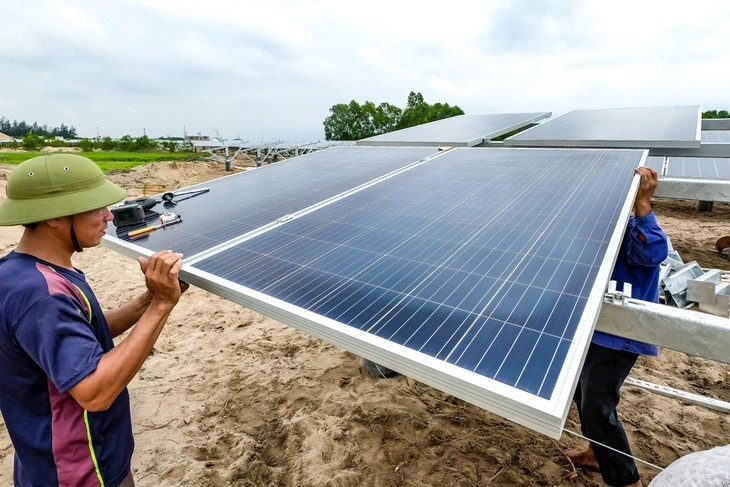
Renewable energy projects will have expanded generation capacity. Photo: Nam Tran
Accordingly, the plan targets supplying domestic electricity demand sufficiently to support socio-economic development, with an average GDP growth rate of 10.0% per year from 2026–2030, and around 7.5% per year from 2031–2050.
Increasing share of renewable energy
To meet this demand, renewable energy sources (excluding hydropower) for electricity generation will be strongly developed, aiming for a share of 28–36% by 2030. The orientation is to reach a renewable energy share of 74 - 75% by 2050.
Regarding power source development, the plan clearly states that the share of renewable energy in the power generation mix and electricity production will continue to increase.
This includes the strong development of onshore, nearshore, and offshore wind power, as well as solar power - particularly floating solar - based on the system’s ability to absorb capacity, the grid’s capability to release the capacity, electricity costs, and reasonable transmission expenses.
Priority is given to encouraging the development of wind and solar power - especially rooftop solar on residential buildings, shopping centers, construction facilities, factories, industrial zones, and at business and production facilities - for on-site consumption, without connecting to or selling electricity to the national grid.
Centralized solar power development must be combined with battery storage systems, with a minimum of 10% capacity and at least 2 hours of storage.
By 2030, the total capacity of onshore and nearshore wind power is expected to reach 26,066 - 38,029MW (Vietnam's total technical potential is around 221,000MW).
The total capacity of offshore wind power serving domestic electricity demand is expected to reach 6,000 - 17,032MW, with operations planned from 2030 to 2035. By 2050, the target is to reach 113,503 - 139,097MW.
Vietnam’s solar power potential is about 963,000MW (ground-based – 837,400MW; floating – 77,400MW; rooftop – 48,200MW).
The total capacity of biomass power sources is approximately 1,523 - 2,699MW; power generated from waste and solid waste is around 1,441 - 2,137MW; and geothermal and other new energy sources contribute about 45MW.
Maximizing the economic and technical potential of hydropower sources (with a total maximum potential of around 40,000MW in Vietnam), while ensuring environmental protection, forest conservation, and water security.
Developing power storage capacity
Regarding energy storage, pumped-storage hydropower plants with a capacity of about 2,400–6,000MW will be developed by 2030. The orientation for 2050 is to reach 20,691–21,327MW of pumped-storage hydropower capacity to balance loads, supply backup capacity, and support large-scale renewable energy integration.
Additionally, the battery storage capacity is expected to reach 10,000 - 16,300MW; by 2050, the target is for battery storage capacity to reach 95,983 - 96,120MW to align with the high proportion of renewable energy.
The plan also targets the commissioning of Ninh Thuận 1 & 2 nuclear power plants between 2030 and 2035, with a combined capacity of 4,000–6,400MW. By 2050, about 8,000MW of nuclear power capacity will need to be added to supply baseload power, and can be increased based on demand.
For coal-fired thermal power, only projects that are already included in the plan and under construction will continue until 2030.
Fuel conversion to biomass or ammonia will be implemented for plants over 20 years old if cost-effective. Plants with a lifespan of over 40 years will be shut down if conversion is not feasible.
Gas power sources will also prioritize the maximum use of domestic gas. If domestic supply declines, additional imports will be made using natural gas or LNG.
The development of LNG-based projects and LNG import infrastructure must be synchronized with an appropriate scale, utilizing modern technology. A roadmap for transitioning to hydrogen fuel will be implemented once the technology is commercialized and cost-effective.
Additionally, investments will be made in developing flexible power sources to balance load demand and maintain grid stability for absorbing large-scale renewable energy. By 2030, the development is projected to reach 2,000 - 3,000MW. The target for 2050 is to reach 21,333 - 38,641MW.
Translator: Thanh Hải
Share